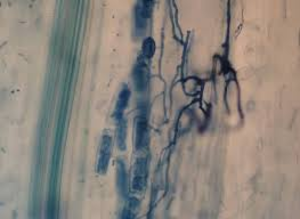Perusing the recent agricultural press would suggest that arbuscular mycorrhizae (AM; some say that the plural is spelt mycorrhizas) are the sole basis of soil health. In one article it is argued that oilseed rape is damaging soil structure because it does not form an association with these soil fungi.
Let us start with a couple of definitions. Mycorrhizae are defined in the web version of the Oxford Dictionary as fungi which grow in association with the roots of a plant in a symbiotic or mildly pathogenic relationship. AM are those mycorrhizae that penetrate the outer layers of plant roots. These have a symbiotic relationship with plants by helping with their nitrogen and phosphate uptake in exchange for the plant giving them some of the products of photosynthesis. However, under severe stress conditions, these fungi turn into self-survival mode and primarily look after themselves at the expense of the plant.
The other benefit of AM is that they form a protein structure, described as glomalin, which helps to bind soil particles into aggregates that make the soil easier to cultivate and form resilient seedbeds.
Some crops potentially have very good associations with AM, such as oats, barley and the legumes. Some crops do not form associations with AM, notably the brassicas including oilseed rape. Hence, the accusation that oilseed rape is damaging to soil structure.
It is the latter comment, which appears to me to be overplaying the properties of AM and prompted me to contact Professor Penny Hirsch of Rothamsted Research. This was also partly because I remember being told at university that a high soil status of nitrates and/or phosphate restricts the abundance of AM.
Prof. Hirsch confirmed that a high nitrogen and/or phosphate status of the soil restricts the abundance of AM and she made the intriguing comment that modern wheats have largely lost the ability to benefit from AM compared to wheats bred before the 1950s. Perhaps the ability to form an association with and potentially benefit from AM has been lost because modern breeding programmes have been carried out in a background of high levels of nitrogen use.
So the wheat and oilseed rape rotations using high levels of nitrogen and with good phosphate supply are perhaps not the best for encouraging the abundance of AM. Despite this, a thirty year plus trial at NIAB TAG Morley is showing, in almost continuous wheat, that current rates of nitrogen produces more dry matter production of straw and presumably roots when compared to zero nitrogen application, leading to a slight increase in soil organic matter. However, despite a small shift in soil organic matter, there is a significant improvement in soil aggregate stability where current rates of nitrogen have been used. This perhaps demonstrates that other soil microflora, which also produce glomalin, have responded to the higher annual incorporation of straw and roots.
It is widely reported in the scientific literature that high levels of AM are beneficial to plant nutrition only where the soil supply of nitrates and/or phosphate is limited. In our conventional systems the supply of these two nutrients is not limited and so the need for assistance from AM is less important.
It seems to me that whilst high levels of soil AM have theoretical advantages, the way we fertilise our crops in conventional agriculture largely or totally negates their ability to improve plant nutrition. The claimed advantage that they produce glomalin is also largely or totally neutralised by the fact that other microflora also form this protein structure that binds soil aggregates. I am an enthusiast for the regular application of organic material to the soil to increase soil microbial biomass but the current enthusiasm specifically to encourage AM seems to me to be overblown.

